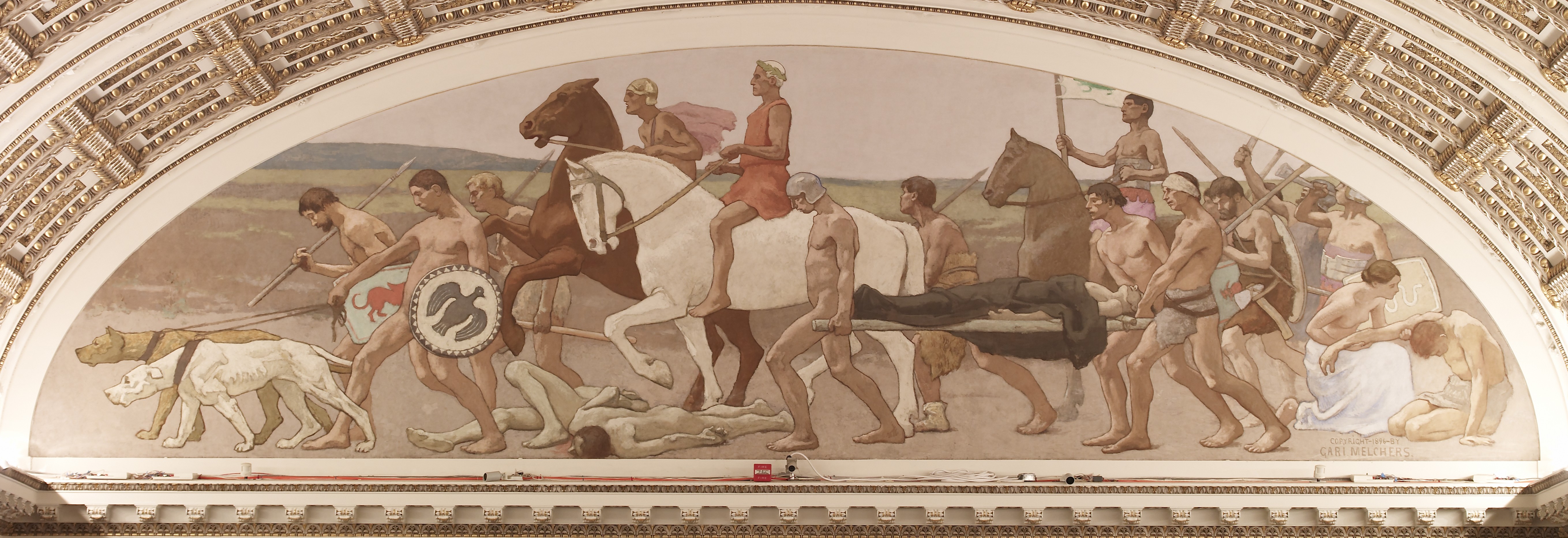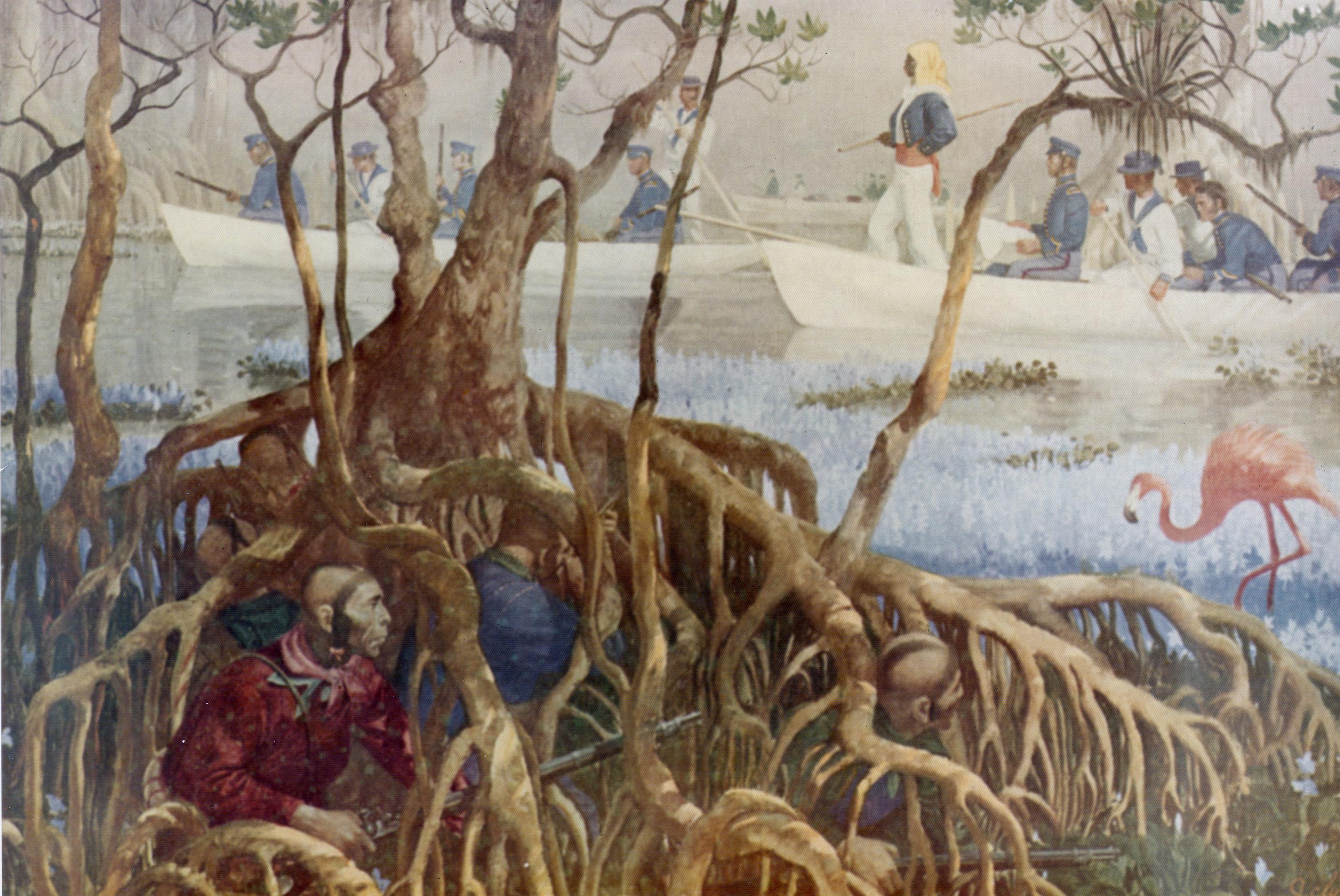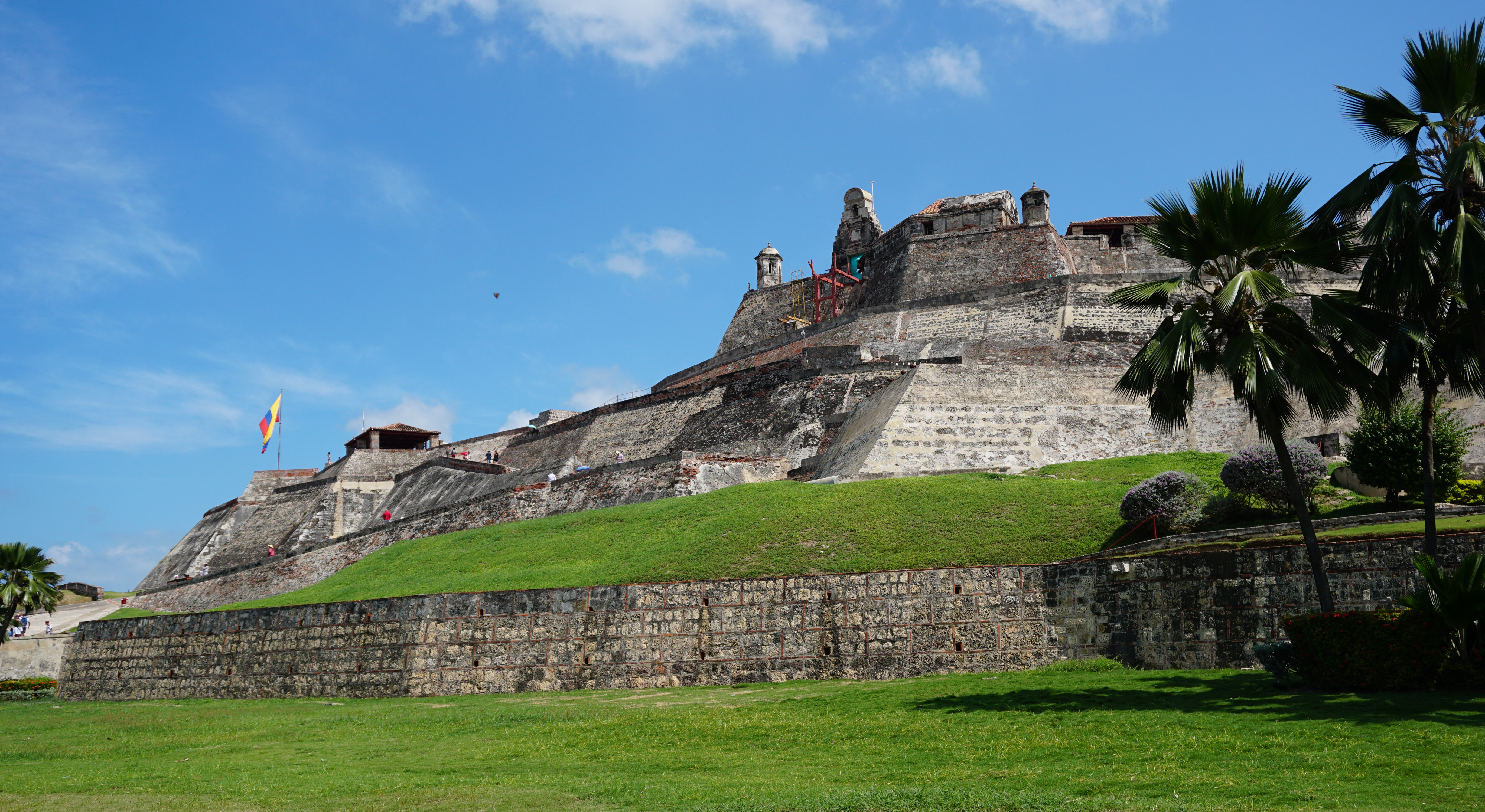|
Fort Early
Fort Early was on the Flint River, in the southwest corner of modern Crisp County, Georgia. It was named for Georgia governor Peter Early. It was, in 1814, no more than breastworks built by the Army on high ground overlooking the river, briefly occupied in preparation for a projected invasion by British forces, a threat which disappeared in 1815 with the end of the War of 1812. A log stockade was built by the Georgia militia in early 1818 and was an important supply depot and defensive point during the First Seminole War. General Andrew Jackson stopped at Fort Early in February 1818 as he marched south to relieve besieged Fort Scott. The fort was evacuated after the war and the site reclaimed by nature. There is a monument erected in 1916 by the Daughters of the American Revolution. References {{coord, 31.8592, -83.9288, type:landmark_region:US-GA, display=title Early Early Early Early may refer to: History * The beginning or oldest part of a defined historical period, as ... [...More Info...] [...Related Items...] OR: [Wikipedia] [Google] [Baidu] |
Flint River (Georgia)
The Flint River is a U.S. Geological Survey. National Hydrography Dataset high-resolution flowline dataThe National Map, accessed April 15, 2011 river in the U.S. state of Georgia. The river drains of western Georgia, flowing south from the upper Piedmont region south of Atlanta to the wetlands of the Gulf Coastal Plain in the southwestern corner of the state. Along with the Apalachicola and the Chattahoochee rivers, it forms part of the ACF basin. In its upper course through the red hills of the Piedmont, it is considered especially scenic, flowing unimpeded for over . Historically, it was also called the Thronateeska River. Description The Flint River rises in west central Georgia in the city of East Point in southern Fulton County on the southern outskirts of the Atlanta metropolitan area as ground seepage. The exact start can be traced to the field located between Plant Street, Willingham Drive, Elm Street, and Vesta Avenue. It travels under the runways of the Hart ... [...More Info...] [...Related Items...] OR: [Wikipedia] [Google] [Baidu] |
Andrew Jackson
Andrew Jackson (March 15, 1767 – June 8, 1845) was an American lawyer, planter, general, and statesman who served as the seventh president of the United States from 1829 to 1837. Before being elected to the presidency, he gained fame as a general in the United States Army and served in both houses of the U.S. Congress. Although often praised as an advocate for ordinary Americans and for his work in preserving the union of states, Jackson has also been criticized for his racial policies, particularly his treatment of Native Americans. Jackson was born in the colonial Carolinas before the American Revolutionary War. He became a frontier lawyer and married Rachel Donelson Robards. He served briefly in the United States House of Representatives and the United States Senate, representing Tennessee. After resigning, he served as a justice on the Tennessee Supreme Court from 1798 until 1804. Jackson purchased a property later known as the Hermitage, becoming a wealth ... [...More Info...] [...Related Items...] OR: [Wikipedia] [Google] [Baidu] |
History Of Georgia (U
History of Georgia may refer to: * History of Georgia (country) The nation of Georgia ( ka, საქართველო ''sakartvelo'') was first unified as a kingdom under the Bagrationi dynasty by the King Bagrat III of Georgia in the early 11th century, arising from a number of predecessor states of t ... * History of Georgia (U.S. state) {{disambig ... [...More Info...] [...Related Items...] OR: [Wikipedia] [Google] [Baidu] |
War Of 1812 Forts
War is an intense armed conflict between states, governments, societies, or paramilitary groups such as mercenaries, insurgents, and militias. It is generally characterized by extreme violence, destruction, and mortality, using regular or irregular military forces. Warfare refers to the common activities and characteristics of types of war, or of wars in general. Total war is warfare that is not restricted to purely legitimate military targets, and can result in massive civilian or other non-combatant suffering and casualties. While some war studies scholars consider war a universal and ancestral aspect of human nature, others argue it is a result of specific socio-cultural, economic or ecological circumstances. Etymology The English word ''war'' derives from the 11th-century Old English words ''wyrre'' and ''werre'', from Old French ''werre'' (also ''guerre'' as in modern French), in turn from the Frankish *''werra'', ultimately deriving from the Prot ... [...More Info...] [...Related Items...] OR: [Wikipedia] [Google] [Baidu] |
Seminole Wars
The Seminole Wars (also known as the Florida Wars) were three related military conflicts in Florida between the United States and the Seminole, citizens of a Native American nation which formed in the region during the early 1700s. Hostilities commenced about 1816 and continued through 1858, with two periods of uneasy truce between active conflict. The Seminole Wars were the longest and most expensive, in both human and financial cost to the United States, of the American Indian Wars. Overview First Seminole War The First Seminole War (1817-1818)-"Beginning in the 1730's, the Spaniards had given refuge to runaway slaves from the Carolinas, but as late as 1774 Negroes idnot appear to have been living among the Florida Indians." After that latter date more runaway slaves began arriving from American plantations, especially congregating around " Negro Fort on the Apalachicola River." Free or runaways, "the Negroes among the Seminoles constituted a threat to the institutio ... [...More Info...] [...Related Items...] OR: [Wikipedia] [Google] [Baidu] |
Forts In Georgia (U
A fortification is a military construction or building designed for the defense of territories in warfare, and is also used to establish rule in a region during peacetime. The term is derived from Latin ''fortis'' ("strong") and ''facere'' ("to make"). From very early history to modern times, defensive walls have often been necessary for cities to survive in an ever-changing world of invasion and conquest. Some settlements in the Indus Valley civilization were the first small cities to be fortified. In ancient Greece, large stone walls had been built in Mycenaean Greece, such as the ancient site of Mycenae (famous for the huge stone blocks of its ' cyclopean' walls). A Greek '' phrourion'' was a fortified collection of buildings used as a military garrison, and is the equivalent of the Roman castellum or English fortress. These constructions mainly served the purpose of a watch tower, to guard certain roads, passes, and borders. Though smaller than a real fortress, the ... [...More Info...] [...Related Items...] OR: [Wikipedia] [Google] [Baidu] |
Daughters Of The American Revolution
The Daughters of the American Revolution (DAR) is a lineage-based membership service organization for women who are directly descended from a person involved in the United States' efforts towards independence. A non-profit group, they promote education and patriotism. The organization's membership is limited to direct lineal descendants of soldiers or others of the Revolutionary period who aided the cause of independence; applicants must have reached 18 years of age and are reviewed at the chapter level for admission. The DAR has over 185,000 current members in the United States and other countries. Its motto is "God, Home, and Country". Founding In 1889 the centennial of President George Washington's inauguration was celebrated, and Americans looked for additional ways to recognize their past. Out of the renewed interest in United States history, numerous patriotic and preservation societies were founded. On July 13, 1890, after the Sons of the American Revolution refused ... [...More Info...] [...Related Items...] OR: [Wikipedia] [Google] [Baidu] |
Fort Scott (Flint River, Georgia)
Fort Scott was built in 1816 on the west bank of the Flint River, where it joins the Chattahoochee River to form the Apalachicola, in the southwest corner of Georgia. It was named for Lt. Richard W. Scott, killed in the Scott Massacre of 1817 and never known to have visited the Fort. (The Fort replaced a much smaller fort or stockade, named Camp Crawford for Secretary of War William H. Crawford, and not to be confused with Fort Crawford (Alabama).) The need for a fort became evident during the War of 1812, when the British identified this undefended United States border, and in 1814 built two forts on the Apalachicola River, into which the Flint River flows: a strong fort at Prospect Bluff and a smaller one, Nicolls' Outpost, at the river juncture. This was in Spanish Florida, but Spain had neither the resources nor the inclination to do anything about this fort in a location to them remote. The Negro Fort (1816) However, the end of the War of 1812 in 1815 meant the fort ... [...More Info...] [...Related Items...] OR: [Wikipedia] [Google] [Baidu] |
First Seminole War
The Seminole Wars (also known as the Florida Wars) were three related military conflicts in Florida between the United States and the Seminole, citizens of a Native American nation which formed in the region during the early 1700s. Hostilities commenced about 1816 and continued through 1858, with two periods of uneasy truce between active conflict. The Seminole Wars were the longest and most expensive, in both human and financial cost to the United States, of the American Indian Wars. Overview First Seminole War The First Seminole War (1817-1818)-"Beginning in the 1730's, the Spaniards had given refuge to runaway slaves from the Carolinas, but as late as 1774 Negroes idnot appear to have been living among the Florida Indians." After that latter date more runaway slaves began arriving from American plantations, especially congregating around " Negro Fort on the Apalachicola River." Free or runaways, "the Negroes among the Seminoles constituted a threat to the instituti ... [...More Info...] [...Related Items...] OR: [Wikipedia] [Google] [Baidu] |
Crisp County, Georgia
Crisp County is a county located in the central portion of the U.S. state of Georgia. As of the 2020 census, the population was 20,128. The county seat is Cordele. The county was created on August 17, 1905, from Dooly County and named for Georgia Congressman Charles Frederick Crisp. Crisp County comprises the Cordele, GA Micropolitan Statistical Area. Geography According to the U.S. Census Bureau, the county has a total area of , of which is land and (3.0%) is water. The western two-thirds of Crisp County, bordered on the east by a line from south of Arabi running northeast, is located in the Middle Flint River sub-basin of the ACF River Basin (Apalachicola-Chattahoochee-Flint River Basin). The eastern third of the county is located in the Alapaha River sub-basin of the Suwannee River. Major highways * Interstate 75 * U.S. Route 41 * U.S. Route 280 * State Route 7 * State Route 30 * State Route 33 * State Route 33 Connector * State Route 90 * State Ro ... [...More Info...] [...Related Items...] OR: [Wikipedia] [Google] [Baidu] |
Militia (United States)
The militia of the United States, as defined by the U.S. Congress, has changed over time.Spitzer, Robert J.: ''The Politics of Gun Control'', Page 36. Chatham House Publishers, Inc., 1995. During colonial America, all able-bodied men of a certain age range were members of the militia, depending on each colony's rule. Individual towns formed local independent militias for their own defense. The year before the US Constitution was History of the United States Constitution#Ratification of the Constitution, ratified, ''The Federalist Papers'' detailed the Founding Fathers of the United States, founders' paramount vision of the militia in 1787. The new Constitution empowered Congress to "organize, arm, and discipline" this national military force, leaving significant control in the hands of State governments of the United States, each state government. Today, as defined by the Militia Act of 1903, the term "militia" is used to describe two classes within the United States: * Organized ... [...More Info...] [...Related Items...] OR: [Wikipedia] [Google] [Baidu] |
Stockade
A stockade is an enclosure of palisades and tall walls, made of logs placed side by side vertically, with the tops sharpened as a defensive wall. Etymology ''Stockade'' is derived from the French word ''estocade''. The French word was derived from the Spanish word ''estacada''. As a frontier outpost It was used as an outpost because it provided cover and was safe to look at things through. As a security fence The troops or settlers would build a stockade by clearing a space of woodland and using the trees whole or chopped in half, with one end sharpened on each. They would dig a narrow trench around the area, and stand the sharpened logs side-by-side inside it, encircling the perimeter. Sometimes they would add additional defence by placing sharpened sticks in a shallow secondary trench outside the stockade. In colder climates sometimes the stockade received a coating of clay or mud that would make the crude wall wind-proof. Builders could also place stones or thick mud lay ... [...More Info...] [...Related Items...] OR: [Wikipedia] [Google] [Baidu] |






.jpg)